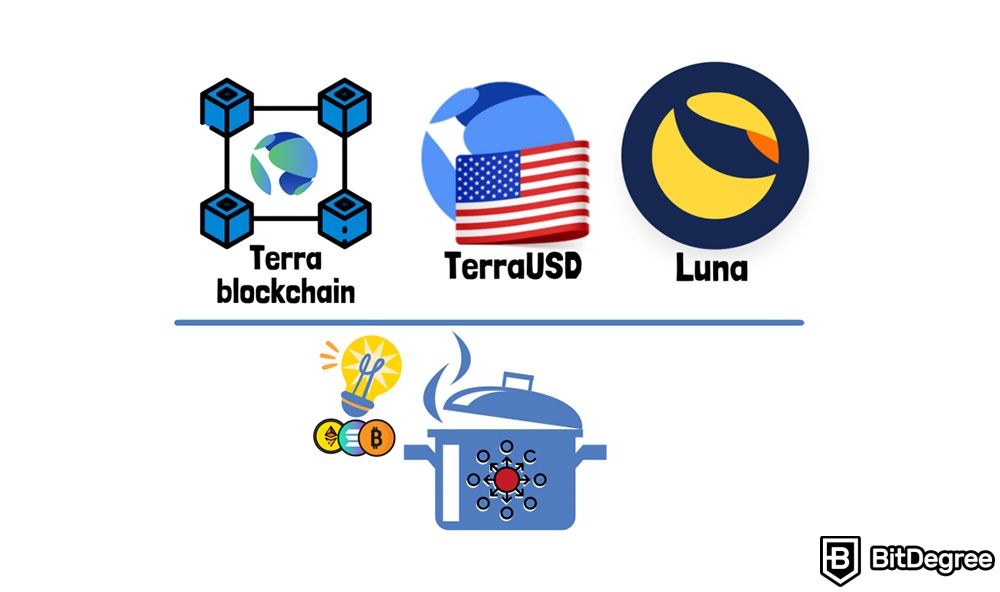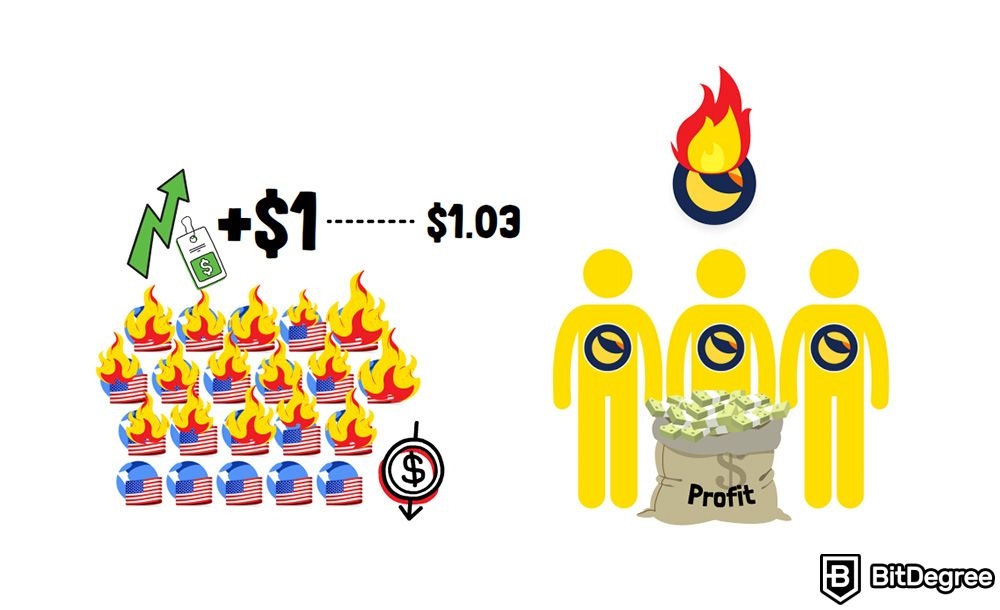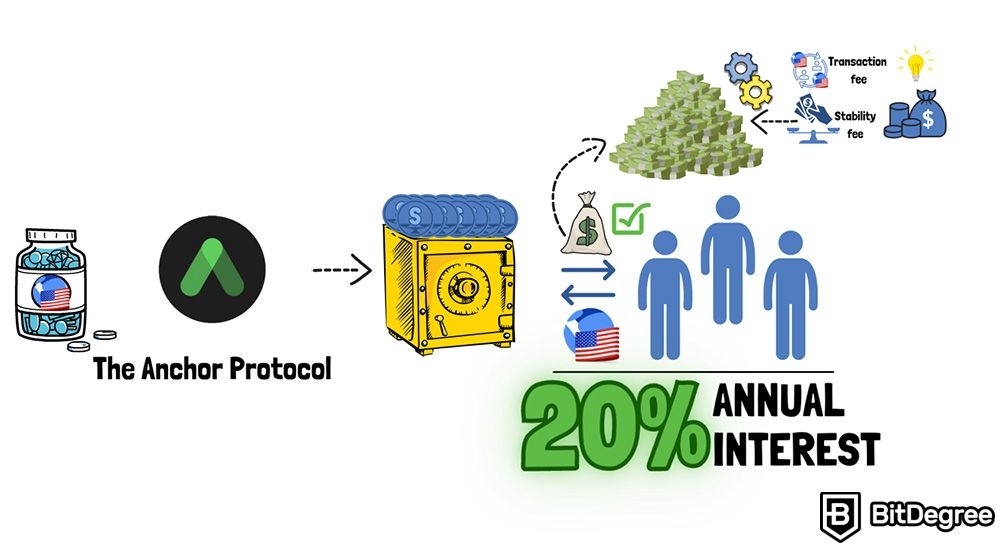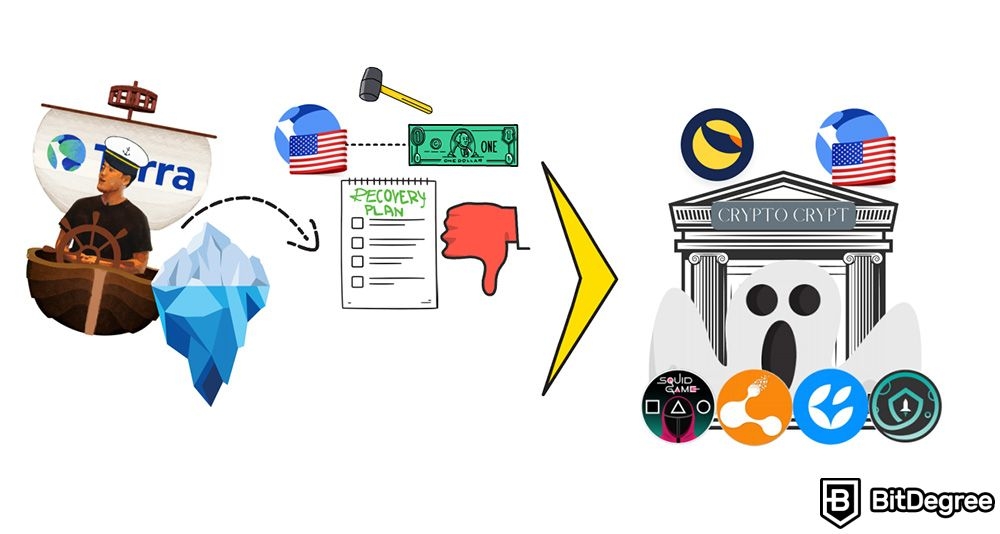The Bumpy Road of Terra (LUNA)
In this section, we’re going to talk about what is Terra Luna coin, and what is Luna’s importance in crypto history!
The question of “What is Luna crypto?” is something that everyone who will ever get into crypto will have to ask, since the name “Terra Luna” is something that you can’t ignore. If there ever was a crypto history book, the Terra (Luna) story would be among the most crucial of chapters. Terra (Luna) embodies some of the most painful lessons that the crypto industry had to go through.
And yet, whether these lessons have been fully learned remains an open question. But there’s one thing that everyone agrees on. It’s the fact that the Terra (Luna) story proved how quick things can change, and, in this case, not for the better.
In this section, we’re going to answer the questions of what is Terra Luna coin and why is it important to know about it. Besides that, we’ll get into more specific details, such as the Terra blockchain, and answer the question, “What network is Terra Luna on?” After finishing this section, you’ll be familiar with the Terra (Luna) saga, and the intricacies that make this story so special and important.
Let’s get to it!

Video Explainer
Video Explainer: The Bumpy Road of Terra (LUNA)
Reading is not your thing? Watch the "The Bumpy Road of Terra (LUNA)" video explainer
What is Terra Luna? History & Crash Explained (ANIMATED)


The Beginning
To begin understanding the story of Terra Luna, let’s go back to 2018. This is the year when two prominent minds - Daniel Shin, the co-founder of one of the largest e-commerce platforms in South Korea, and Do Kwon, an eager entrepreneur, and a Stanford Computer Science graduate, came together and founded Terraform Labs.

Terraform Labs was created with the goal of building a decentralized and price-stable cryptocurrency that could eventually transform the world of finance. To do so, the company created their own blockchain, which was called the Terra blockchain.
This allowed them to present to the world a stablecoin that was native to the Terra blockchain. It was called TerraUSD, or simply “UST.” It was supposed to be a very intricate coin, which relied on another crypto coin - Luna, which was also native to the Terra blockchain.
This project was all about combining the best of the two worlds: the decentralization possible in the crypto realm, and the stability of traditional bank-issued fiat money. A successful combination of these two ingredients would result in a stablecoin, a coin with a stable price of $1. Though, do note that some stablecoins are pegged to a fiat currency, like the US dollar, while others rely on sophisticated algorithms to remain stable. Terra USD was an algorithmic stablecoin.

The Terra blockchain, the TerraUSD stablecoin, and the Luna coin were supposed to be the three ingredients that were needed to create the DeFi-transforming crypto solution. Right from the beginning, Terraform Labs received critical acclaim and interest from investors.
During the initial funding round, the company raised $32 million. Among investors were such names as Binance Labs or Huobi Capital. The world believed in Terraform Labs’ potential.
So, what was so special about this supposedly revolutionary crypto solution? Well, on the surface, it looked like brilliant minds really came up with a brilliant idea. Before things really went down, this mechanism seemed to be effective, promising, and game-changing.
Algorithmic Stablecoin
As said before, TerraUSD, the stablecoin, was an algorithmic stablecoin. This means that it relied on a complex mechanism that involved algorithmic adjustments of the money supply based on supply and demand dynamics, so it could operate while automatically ensuring price stability and mitigating volatility risks.
Here’s how this mechanism worked.

When the market demand for TerraUSD soared, surpassing its target value, which was a fixed price of $1, the system was set to stabilize it. TerraUSD holders were enticed to burn their TerraUSD in exchange for discounted Luna, thereby reducing the supply of TerraUSD and restoring its price to the desired level.
This process of burning TerraUSD played a crucial role in maintaining the stability that a stablecoin requires. Additionally, to maintain stability, a stability fee was imposed on TerraUSD transactions, usually paid in Luna. This fee served as a compelling economic incentive, motivating participants to diligently uphold the stability of the entire ecosystem.
To make things clearer, let’s get more particular.
For example, if the price of TerraUSD would fall to, let’s say, $0.95, the algorithm would step in and solve the problem. Since you were supposed to always be able to exchange 1 TerraUSD for $1 worth of Luna, this would mean that every TerraUSD holder could make an immediate $0.05 profit by exchanging the TerraUSD for $1 worth of Luna. This would result in people making a profit, while the supply of Terra USD would reduce and make its price increase again back to $1.

But what if so many TerraUSD coins would get burned that its price would actually increase over $1, and reach, let’s say, $1.03? This would mean that Luna holders could burn $1 worth of Luna and once again make a profit, thus increasing the amount of Terra USD coins, and reducing its value.
Through these meticulously crafted mechanisms, TerraUSD successfully maintained its peg and provided a solid foundation within the Terra ecosystem.
When you put it down like this, it makes it easier to understand why Terraform Labs was so successful. This truly seemed like a revolutionary solution! But… as the most devastating fires can start from a single unattended candle, so did this seemingly-flawless mechanism fall apart when the weak chain link suddenly made itself present.
Anchor Protocol
Technical ingenuity is rarely the reason behind a company’s or product’s success. There often has to be something more. A charismatic leader, a great ad campaign, or, for example, an opportunity to make money.
And, of course, the creators behind Terra Luna had something else up their sleeves. The trick was called: passive income. They knew how to make the word spread, and get people googling “what is Luna crypto?”.
Terraform Labs unveiled something that at first may have seemed to be too good to be true. And as it later turned out – it was.
It was called the Anchor Protocol – a stablecoin savings platform, where users could deposit their Terra stablecoins, and earn interest on their deposits.

This was possible by utilizing the yield generated from sources such as stablecoin stability fees, transaction fees, and similar yet related sources.
It was something like a savings account but for TerraUSD. And, at one point, this “TerraUSD savings account” caught everyone’s attention for a reason. Those who chose to keep their assets in it were promised 20% annual interest. It basically meant that if you locked away 1000 TerraUSD, you’d receive $200 for doing nothing. So, the word spread, and Terra’s project took off even faster.
Do Kwon’s Antics
To continue answering the “What is Luna crypto?” question, it’s important to take Do Kwon and his behavior into account. It very much contributed to the reason why this story got so famous.
From its launch in 2019 till 2021, Luna’s price increased over 100 times, reaching an all-time high of $119, eventually becoming one of the top cryptocurrencies. This further continued to raise the coin’s value and inflated people’s trust in it, as well as Do Kwon’s ego.
As mentioned before, Do Kwon was one of Terraform Labs’ co-founders. But, at this point, his role in the company grew, and eventually, he became the face of the Terra project. Kwon enjoyed this fame and didn’t even pretend to be humble.

With a Twitter bio stating that he’s the ‘Master of Stablecoin’, and with increasing confidence, he proudly rocked the fact that he’s been listed on the “Forbes 30 under 30” list. A successful company, run by a charismatic, clever, confident and insightful leader - it was truly the ultimate combo that promised a bright future, and Do Kwon was the captain of the ship that was taking humanity in this direction.
But fame did get into Do Kwon’s head. A problem with his attitude started appearing. His arrogant rhetoric blinded him, even when people were sending warnings about the vulnerable points of the Terra project. Instead of listening to them, he resorted to calling them ‘poor’. And then, Do Kwon was about to learn a painful lesson.
Sudden Collapse
In March 2022, Anchor Protocol, the already-described TerraUSD savings account, announced that they’d be replacing the fixed 20% interest rate with a variable rate. This caused a panic signal.
People started burning their TerraUSD in exchange for Luna. Its price started freefalling, since its quantity inflated very quickly. This was another panic signal, which resulted in people continuing to dump their TerraUSD. Luna’s price continued falling down – the balance mechanism was breaking apart.
A death spiral began spinning, Luna crashed to unseen lows, and hasn’t recovered ever since.

The “unsinkable” crypto project crashed into an iceberg. Despite a recovery plan being announced and efforts put into restoring the TerraUSD peg to the dollar, things don’t really seem to get better. And it got more and more clear that the Luna coin, together with the TerraUSD stablecoin, were banished into the crypto crypt, where they were about to join the other failed coins.
In just around 3 days, over $40 billion of value just evaporated. Thousands of investors lost their savings. This was a crisis, and people were angry.
Do Kwon’s Escape
The severity of the situation meant that Do Kwon was in trouble. Many people lost a lot of money. And the man behind the Terra Luna project was the one responsible for all of that.
At first, the police were sent to guard Do Kwon’s family in South Korea. Law enforcement officers expected Do Kwon to be cooperative and good-willed, since the whole Terra Luna collapse seemed more like a disaster, and not like a malicious master plan executed recklessly.

But they were in for a surprise. The police in Singapore, the country where Terraform Labs was registered, eventually realized that Do Kwon had fled. He immediately tweeted that he was “not on the run.”
But Korean prosecutors stated the obvious – he’s most definitely on the run. And to catch him, the country had asked for global police assistance. This resulted in Do Kwon receiving a “red notice” from Interpol, which meant that, from now on, law enforcement agencies worldwide will go after him.
And, eventually, the news broke out that Do Kwon was arrested in Montenegro.
Terra Now
For what concerns the TerraUSD and Luna coins, a recovery plan was proposed. However, it didn’t really quite do what it was supposed to do. These two (now notorious) coins were rebranded into TerraClassicUSD and Terra Classic, respectively, so that people could easily differentiate between the “old” failed project and the "new" promising one.
And this “new” project was called Terra 2.0 (Luna). It’s a new token, and it’s native to a new chain. The rules of its distribution were changed, and efforts were made to make it look like the “attack” that took down the entire Terra Luna ecosystem resulted in unfair losses that must be compensated. Therefore, the new token was being airdropped to previous UST holders and believers in Terra Luna.
However, despite these efforts at reviving a failed ecosystem, the future of Terra 2.0 (Luna) does not look very bright. Well, in case of a recovery, that would be the comeback of the century.
Wrapping Up
This brings us to the end of the section. I hope that, by now, the questions like “What is Luna crypto?”, “What is Terra Luna coin?”, or “What network is Terra Luna on?” will no longer bother you. And, in addition, you’ll know all about one of the most groundbreaking crypto collapse cases that has taken place. It’s a lesson for everyone, after all.















